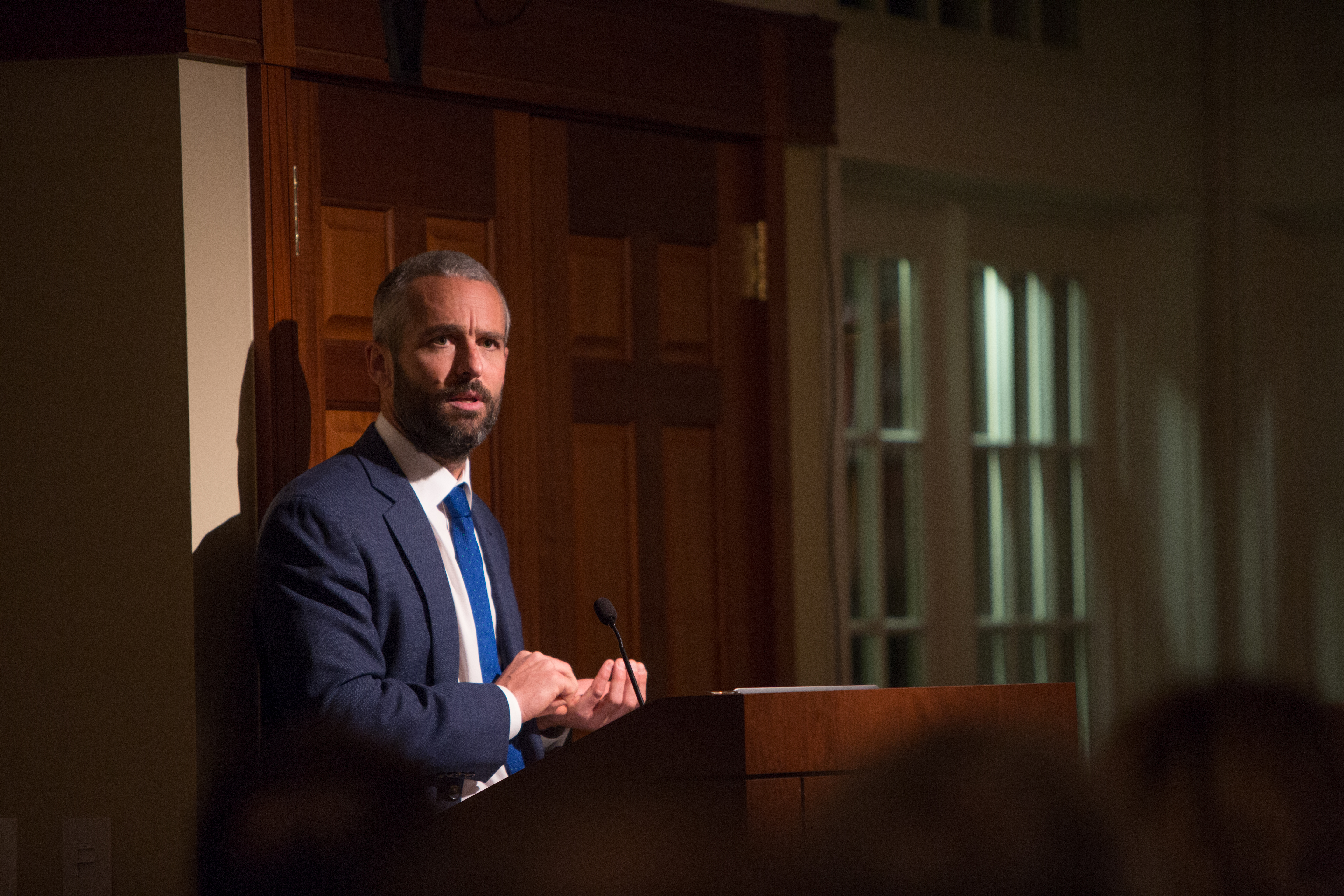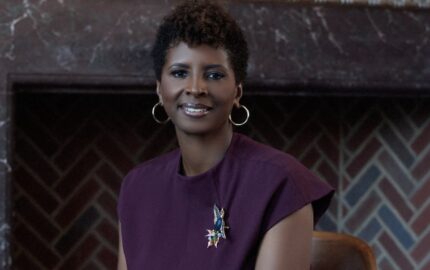Some of the most compelling, controversial images of conflict and terror in recent memory — a woman hiding with her children, motionless on a restaurant floor, a man carrying a boy’s body along a Gaza beach — have come from the camera of New York Times photographer Tyler Hicks. Hicks, whose work has taken him to Syria, Libya and many other troubled spots, won the 2014 Pulitzer Prize in breaking news photography for his images of the Sept. 21, 2013 terrorist attack on the Westgate shopping mall in Nairobi and was a member of the Times team awarded the 2009 Pulitzer in international reporting for coverage of Afghanistan and Pakistan. In 2006, he was named Newspaper Photographer of the Year by Pictures of the Year International.
Hicks recently visited the Nieman Foundation to deliver the annual Joe Alex Morris Jr. Memorial Lecture, which brings an American overseas correspondent or commentator on foreign affairs to Harvard to discuss international reporting. Before his speech, Hicks sat down with Storyboard and talked about working with reporters, the ubiquity of imagery and the one subject he’d most like to shoot. An edited conversation follows:
You work so closely with reporters, with people who are writing stories, and of course, you’re telling a story with images. Is your method the same, or different? How do you think the same or differently about storytelling? How much autonomy do you feel in that relationship? How much is it a two‑way street?
It depends on the reporter. It’s natural for some photographers and reporters to work really well together, and other relationships can be completely poisonous, terrible.
When you do find that right combination, it works very well. For me, I was lucky, I teamed up with Chris Chivers and we spent 10 years covering wars together, and we’re very good friends. It’s like going on the road with your fishing buddy. You have to have that relationship so you don’t end up killing each other.
Living next to somebody under those circumstances, where you can go a month or longer where you’re never more than 10 feet away from somebody. That would be true for Afghanistan, Syria, Libya. You’re always in the same space, whether it’s the same car, or the same military vehicle, whether you’re sleeping next to each other in sleeping bags. You have to have a pretty high tolerance for that person. I don’t care how well you get along.
I’d say with Chivers, he’s usually the one driving the direction of the story, but it puts me in places that I would never normally go. I think that I’m right, and then it turns out I’m not. Sometimes, I might see something that he doesn’t see. It really does work to have that type of relationship.
That said, I also work on my own sometimes. Gaza, where I was working most recently, is a good example of that, where my needs are much different than the reporter’s needs.
That’s very much a visual story that requires a higher level of risk that there’s absolutely no reason for the reporter to be taking. They can get those stories in the hospital and not go out at the times of day when things are more likely to happen, so I actually make a point not to work with a reporter in that place.
What about the public or political response to some of your images? You get such a strong response to a photograph that is a photograph of an event, but is interpreted politically as favoring one side or the other. Does that affect you personally and professionally? Is that something that you’re mindful of when you’re shooting, or think about afterward?
No matter how you’re doing it, there’s going to be an imbalance. The New York Times tries to balance that as much as possible. In the case of Gaza, having a photographer on the Palestinian side and another photographer on the Israeli side, and balance those images as far as how they’re run in the newspaper.
My role in that is very small. My job is to take pictures, to send them to the New York Times, and then that’s the end of my responsibility with it.
It actually can be very frustrating and distracting to look too much at what the dialogue is, with so much access. With so much freedom for people to respond to those photographs, it can become very emotional.
On the one hand that’s what covering news is all about. I take a photograph or a story runs, and that’s up to the reader or the viewer to interpret in any way they want. One person might look at a photograph I’ve taken and view it as some kind of propaganda. The other might see it as underscoring the civilian casualties at the hands of the Israeli military, and everything in between.
After I’ve sent my photographs, and being in Gaza, where it is very political, and you’re at the end of the day very exhausted, the best thing to do is not to go and start reading through the reams of comments.
Is it harder to be a photographer now that there are so many channels for people to talk back?
It’s not harder, I think it’s different. It’s not just about how people communicate in regard to pictures, but it’s also about the amount of photographs that are out there.
I think back to when I worked in the Balkans, that some of the first assignments I had for the New York Times, there was a Times reporter and a photographer that worked with that reporter, and that was it. It would be pretty rare for them to use any other picture, or for you to ever see a picture outside of that run in the New York Times.
Today, no matter what you see or get in any given place or time, there’s going to be 100 other people who have taken pictures and sent them, and the Times has seen them. There’s a lot more competition, but then you have to ask yourself, what is that competition? How do we determine, how do we decide what is valid news?
We work for a place like the Times because we have a certain track record, and they trust us, and there’s a book of ethics that we follow. All that’s got thrown out the window, and it’s this buffet of pictures out there. Are we just going to publish those because somebody said this is true, and this isn’t set up, this really happened?
In some cases, yes. There’s always that footnote these days. “This is something, a photograph that was said to be taken of,” or “Believed to be of,” and there’s a lot less of, “This happened, because we know where this came from.”
Do you think the ubiquity of imagery devalues the kind of work that you do, or makes it even more important?
It makes the work more important, because we have to keep up the tempo of quality news. The highest‑quality news is that marriage between a story and a photograph that comes from the reporting, and the team.
I’ve always worked for newspapers, whether it’s for the New York Times or small daily newspapers domestically before that, where I’ve always been teamed up with a reporter. Where sometimes you might feel that slows you down, much more common is that it actually makes your field of view much wider, and brings a much richer amount of information to the reader.
That’s really what we’re after. If I take a photograph and it doesn’t run, or it doesn’t get published, or it doesn’t have context, then the picture’s not ever worth taking if it’s not seen. It has to be seen, it has to be digested, in order for it to have any value whatsoever.
What would you like to shoot that haven’t yet had the chance to shoot?
I’d like to have complete access to see behind the lines of ISIS…That’s something that we haven’t seen. Aside from their own propaganda, what they masquerade as news, which is very controlled and very fake. To actually see how they’re fighting this, and how they’re controlling people, to have access to that today would be extremely valuable.



